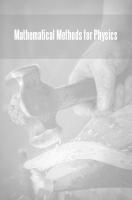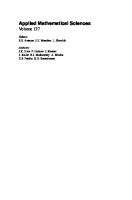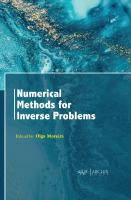Inverse Problems of Mathematical Physics 9783110926019, 9783110460551
279 126 19MB
English Pages 246 [248] Year 1986
Contents
Foreword
Chapter 1. Introduction
Chapter 2. Inverse Problems For The Operator Lq = (D2/Dt2) — (D2/Dx2) + Q(X)
Chapter 3. Inverse Kinematic Problems In Seismology
Chapter 4. Second-Order Equations Of A Hyperbolic Type And Related Inverse Problems
Chapter 5. Inverse Problems For First-Order Linear Hyperbolic Systems
Chapter 6. Inverse Problems For Parabolic And Elliptical Type Second-Order Equations
References
Recommend Papers

- Author / Uploaded
- V. G. Romanov
- L. Ya Yuzina
File loading please wait...
Citation preview
Inverse Problems of Mathematical Physics
Related Titles of Interest
Modelling Non-Linear Wave Processes Yu. A. Berezin Inverse Sturm-Liouville Problems B. M. Levitan Electromagnetic Inverse Profiling: Theory and Numerical Implementation A. G. Tijhuis Group Theoretical Methods in Physics Proceedings of the Third Yurmala Seminar, Yurmala, USSR, 1985
For further information please contact the Publisher
Inverse Problems of Mathematical Physics
V. G. ROMANOV Siberian Branch, Computing Centre, USSR Academy of Sciences Translated by L. Ya. Yuzina
WWNU SCIENCE PRESS B Viii
Utrecht, The Netherlands
VNU Science Press BV P.O. Box 2093 3500 GB Utrecht The Netherlands © 1987 VNU Science Press BV First English edition published 1987
All rights reserved. No part of this publication may be reproduced, stored in a retrieval system, or transmitted, in any form or by any means, electronic, mechanical, photocopying, recording, or otherwise, without the prior permission of the publisher.
CIP-DATA KONINKLIJKE BIBLIOTHEEK, DEN HAAG Inverse problems of mathematical physics/V. G. Romanov: transl. [from the Russian] by L. Ya. Yuzina.—Utrecht: VNU Science Press With ref. ISBN 90-6764-056-5 bound SISO 517 UDC 53.01 Subject heading: mathematical physics.
Phototypesetting by Thomson Press (India) Limited, New Delhi Printed in Great Britain by Butler & Tanner Ltd, Frome and London
Contents Foreword by V. G. Yakhno
vii
1. Introduction 1.1. Inverse problem concept: examples of formulating inverse problems 1.2. On correctness of direct and inverse problems of mathematical physics 2. Inverse problems for the operator Lq = (d2/dt2) — (d2/dx2) + q(x) 2.1. Problems with nonfocused initial data 2.2. Some aspects associated with the inverse problem for the equation Lqu = F 2.3. Problems with a focused source of disturbance 2.4. Reducing the problem with a focused source of disturbance to a linear integral equation: necessary and sufficient conditions for the inverse problem solvability 2.5. Inverse problems for differential equations in a limited domain 2.6. Relationship with the Sturm-Liouville problem 2.7. One-dimensional inverse problems for second-order linear hyperbolic equations 2.8. Problem of determining the operator Lq in a second-order hyperbolic equation 3. Inverse kinematic problems in seismology 3.1. Iconical equations, rays, and fronts 3.2. Boundary rays; waveguides: a sufficient condition for the absence of waveguides and boundary rays—ray regularity 3.3. One-dimensional inverse kinematic problems 3.4. Linearized three-dimensional inverse problems 3.5. Nonlinear three-dimensional inverse problems 3.6. Inverse problems using inner sources 3.7. Inverse kinematic problems for an anisotropic medium 4. Second-order equations of a hyperbolic type and related inverse problems 4.1. Fundamental solution and its differential properties 4.2. Ray formulation of inverse problems for the coefficients at minor derivatives V
1 1 11 18 18 29 32
39 46 53 57 62 64 64 69 74 80 92 96 97
111 111 121
vi
Contents
4.3. Inverse dynamic problem: linearization method 4.4. General scheme of studying inverse problems for hyperbolic type equations
141
5. 5.1. 5.2. 5.3. 5.4. 5.5. 5.6.
149 149 155 163 166 177 191
Inverse problems for first-order linear hyperbolic systems Systems of equations with a single spatial variable Inverse problems using focused sources of wave generation Problem of determining the right-hand part of a hyperbolic system Lamb one-dimensional inverse problem Lamb three-dimensional inverse problem within a linear approach Inverse problem for a system of Maxwell equations
6. Inverse problems for parabolic and elliptical type second-order equations 6.1. Problem of determining the density of heat sources 6.2. Problem of determining diffusion coefficients 6.3. Relations among inverse problems for parabolic, elliptical, and hyperbolic type equations 6.4. On specific formulations of inverse problems where the coefficient to be determined is independent of one of the variables
134
208 208 210 213 218
References
221
Index
240
Foreword The monograph surveys basic features of the comparatively newly emerged theory of inverse problems for equations of mathematical physics, i.e. of the problems aimed at defining the coefficients of a differential equation through some functionals of its solution. Problems of the kind arise in various fields of science when trying to describe internal characteristics of the substance where physico-chemical processes take place by the results of observing these processes within the available range of measurements. The book offers in-depth coverage of inverse problems for second-order equations and for hyperbolic systems of first-order equations, including the kinematic problem of seismology, the Lamb dynamic problem for equations of the theory of elasticity, and the problem of electrodynamics. The book is intended for specialists in applied mathematics, physics, and geophysics, as well as for university students of corresponding fields. V. G. YAKHNO NAUKA, Moscow 1984
vii
Chapter 1 Introduction 1.1. Inverse problem concept: examples of formulating inverse problems Mathematical physics commonly deals with problems of the following type: a differential equation, with its solution obeying certain additional conditions given; as a rule, the additional conditions single out one of the solutions of the differential equation from a whole set of possible solutions. There exists a differential classification based on their types, each class characterized by a typical formulation of problems. For instance, the Cauchy problem or the boundary problem for hyperbolic and parabolic equations, the Dirichlet and Newmann problems for equations of elliptical type; a characteristic feature of these typical problems being their correctness. Henceforth, correct boundary problems considered in mathematical physics will be referred to as direct ones. Setting a direct problem implies the idea of setting a certain number of functions, one part of these functions determining the differential equation (for instance, linear equation coefficients), the other part determining the boundary conditions. A direct problem solution results in the fact that a new function, i.e. the boundary problem solution, is determined by a given set of functions, and a certain new operator, conditioned by the direct problem data, arises. Assume that some of the functions commonly set in direct problems are unknown (it is their determination that is of interest) and instead of them some additional information on the direct problem solution is given. Such problems will be referred to as inverse ones and will be the subject of this book. Additional information on the direct problem solution (or on a solution of a series of direct problems) may be of various types. It can be, for instance, the solution proper given on a certain set of independent variables or some integral characteristics of the solution (solution functionals). If in an inverse problem the functions considered are members of the differential equation only, the task is to determine the differential equation. There exist some other types of inverse problems, for example, problems of determining initial and boundary conditions. Consider some examples of inverse problems. Example 1. Let q(x) be a continuous throughout the X-axis function. Consider the Cauchy problem for the function u(x, y) (1.1)
u(x, 0) = 4>(x), l
xeR.
(1.2)
2
Inverse problems of mathematical
physics
When functions q, are given, problems (1.1) and (1.2) are set correctly. F o r the solution of the problem to be classical (the solution is continuous together with its partial derivatives in the space R2),
it is sufficient to require continuous
differentiability of the function (x). Let this condition be fulfilled. N o w consider the problem of determining the function q(x)
on the basis of the following
information on the solution of problems (1.1) and (1.2) «(O^H^y),
(1.3)
yeR.
Analysis of the problem does not present any difficulty. Indeed, the solution of problems (1.1) and (1.2) is set by
M(x,;y) = 4>(x + > > ) e x p ( J
q(Z)d{J,
(x,y)eR2.
Condition (1.3) results in the equality
=
(1.4)
yeR.
Equality (1.4) shows that uniqueness of the inverse problem solution depends greatly on the measure of the set of zeros of function 4>(x). If the measure equals zero, the inverse problem has a unique solution, while in case of a positive measure there exists an unlimited number of solutions. Without going into the details of a general situation, let us assume that (x)^0,xeR.
In this case the
inverse problem solution is unique and for its existence it is necessary and sufficient that the function ij/(y) possesses the following properties: (1) ij/(y) is c o n t i n u o u s l y d i f f e r e n t i a b l e f o r yeR,
a n d ( 2 ) ^{y)/(y) > 0, yeR,
(0).
In this case the inverse problem solution is set by the formula d
Example
il/(x)
2. In connection with problems (1.1) and (1.2) let us consider the
problem of determining continuous the function q(x) on the basis of the following information on the solution: u(x, h) = >j/(x),
xeR,
h>
0.
(1.6)
T h e problem formulated is analogous to that of determining q{x) by the equality
{¡/(x) = (x)^0,xeR.
q m t
F o r the solution to exist the following conditions are
necessary: (1) i¡/(x) is continuously differentiable for xeR; xeR.
(1.7)
(2) ij/(x)/{x + h)>
0,
Introduction
3
When the above conditions are fulfilled, (1.7) is equivalent to the equalities d
il/(x)
dx
{x + hY
/(x) = — I n -
q(x) - q(x + />) = f ( x ) ,
'
MO)


![An Introduction to the Mathematical Theory of Inverse Problems [3 ed.]
9783030633424, 9783030633431](https://ebin.pub/img/200x200/an-introduction-to-the-mathematical-theory-of-inverse-problems-3nbsped-9783030633424-9783030633431.jpg)






